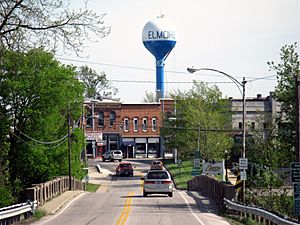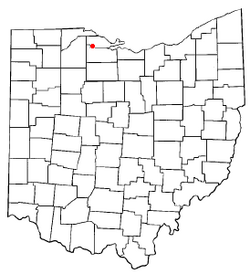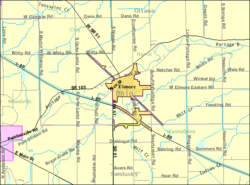Elmore, Ohio facts for kids
Quick facts for kids
Elmore, Ohio
|
|
|---|---|
|
Village
|
|

Elmore in 2012
|
|

Location of Elmore, Ohio
|
|

Detailed map of Elmore
|
|
| Country | United States |
| State | Ohio |
| Counties | Ottawa, Sandusky |
| Area | |
| • Total | 0.82 sq mi (2.13 km2) |
| • Land | 0.82 sq mi (2.13 km2) |
| • Water | 0.00 sq mi (0.00 km2) |
| Elevation | 617 ft (188 m) |
| Population
(2020)
|
|
| • Total | 1,370 |
| • Estimate
(2023)
|
1,374 |
| • Density | 1,664.64/sq mi (643.07/km2) |
| Time zone | UTC-5 (Eastern (EST)) |
| • Summer (DST) | UTC-4 (EDT) |
| ZIP code |
43416
|
| Area code(s) | 419 |
| FIPS code | 39-25144 |
| GNIS feature ID | 2398815 |
| Website | http://www.village.elmore.oh.us/ |
Elmore is a small village located in the state of Ohio, in the United States. It is split between two counties: Ottawa and Sandusky. In 2020, about 1,370 people lived there.
The part of Elmore in Ottawa County is near the big city of Toledo. The part in Sandusky County is closer to Fremont.
Contents
History
Elmore is in an area that used to be called the Black Swamp. This was a huge marsh that covered much of northwest Ohio. Native American tribes lived here for a long time. The Portage River flows next to Elmore. Its name likely comes from early explorers. They had to carry their canoes around shallow or fast-moving parts of the river. This act is called "portaging."
German settlers started moving here in the early 1800s. They worked hard to drain the swamp and clear the thick forests. This revealed rich soil, which was great for farming. A busy railroad also helped the village grow. Elmore was officially planned out on October 2, 1851. The land around Elmore is very flat.
Sawmills nearby made wooden "planks" or boards. These were used to build a muddy "plank road," which is now U.S. Route 20. This road connected Fremont, Ohio, and Perrysburg, Ohio. Later, the Ohio Turnpike was built in the 1950s. It became the main road across northern Ohio, taking traffic away from US 20. This change affected many towns along US 20, including Elmore.
Elmore was once home to the Elmore Manufacturing Company. This company made the "Elmore automobile." It was one of the first companies bought by W.C. Durant, who then started General Motors. The car factory later moved to Clyde. A nearby factory that works with beryllium is also important. Beryllium is used in nuclear power, nuclear weapons, and space technology.
Today, Elmore is a small town. Its main business area has faced some challenges. The old New York Central railroad left many years ago. Also, the Ohio Turnpike bypassed the village, making it less of a transportation hub. However, a new Turnpike exit was built in 1997. This has created new chances for Elmore. Many people who live in Elmore now travel to Toledo or other nearby cities for work. The village wants to be a fun place for visitors.
Recently, new stores have opened downtown, bringing some success. Village leaders have tried to make the area more appealing. They added old-fashioned streetlights and fixed up the train depot. The yearly Portage River Festival and other local events attract people. There's even a well-known story about a headless motorcycle-riding ghost that brings visitors to the area!
In 2011, Elmore was in the national news. This was because the mayoral election featured two brothers: Lowell Krumnow, the mayor at the time, and his older brother, James Krumnow, a councilman.
Geography
Elmore covers a total area of about 2.13 square kilometers (0.81 square miles). All of this area is land.
Population Information
| Historical population | |||
|---|---|---|---|
| Census | Pop. | %± | |
| 1870 | 1,131 | — | |
| 1880 | 1,044 | −7.7% | |
| 1890 | 1,198 | 14.8% | |
| 1900 | 1,025 | −14.4% | |
| 1910 | 937 | −8.6% | |
| 1920 | 937 | 0.0% | |
| 1930 | 1,107 | 18.1% | |
| 1940 | 1,103 | −0.4% | |
| 1950 | 1,215 | 10.2% | |
| 1960 | 1,302 | 7.2% | |
| 1970 | 1,316 | 1.1% | |
| 1980 | 1,271 | −3.4% | |
| 1990 | 1,334 | 5.0% | |
| 2000 | 1,426 | 6.9% | |
| 2010 | 1,410 | −1.1% | |
| 2020 | 1,370 | −2.8% | |
| 2023 (est.) | 1,374 | −2.6% | |
| U.S. Decennial Census | |||
2010 Census Details
In 2010, there were 1,410 people living in Elmore. There were 558 households and 389 families. The village had about 643 people per square kilometer (1,664 people per square mile).
Most people in Elmore were White (96.4%). A small number were African American (0.5%), Native American (0.2%), or Asian (0.1%). About 5.7% of the population was Hispanic or Latino.
About 33% of households had children under 18 living with them. Most households (58.4%) were married couples. The average household had 2.53 people. The average family had 3.08 people.
The average age in Elmore was 38.6 years. About 27.2% of residents were under 18. About 17% were 65 or older. The population was almost evenly split between males (48.7%) and females (51.3%).
Arts and Culture
Elmore is home to Schedel Arboretum and Gardens. This used to be a large estate owned by a wealthy local businessman. Now, it is a beautiful place with many different plants and trees. It's like a special garden preserve.
The Portage River is also important for fun activities in Elmore. Two parks, Walter Ory Park and Riverbend Park, are located along the river. These parks offer places for people to relax and play outdoors.
Education
The Woodmore Local Schools district serves Elmore. It has one elementary school, one middle school, and Woodmore High School.
Elmore also has a public library called the Harris-Elmore Library. It's a great place to find books and learn new things.
Notable People
- Clara Blinn, a person who was kidnapped in the past.
See also
 In Spanish: Elmore (Ohio) para niños
In Spanish: Elmore (Ohio) para niños

